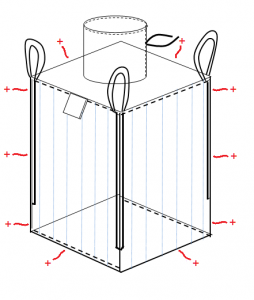What are the differences between type A B C and D FIBC Bags
Bulk
Bags are classified according to one of four Types: A, B, C and D.
Type A Bags
Type A FIBCs are made of plain-woven polypropylene and other non-conductive fabrics. Static electricity is generated as products move over or rub against the inside surface of the bulk bag when they are filled/emptied. There is no static protection provided by Type A FIBCs
Type A bulk bags can be used to safely transport
non-flammable products. There should not be any flammable solvents or gases
present around a Type A FIBC.
Safe
use for type A FIBC Bags:
- To transport non-flammable products.
- No flammable solvents or gases present around the bag.
Do not use type A FIBC Bags for:
- Transporting flammable products.
- When flammable solvents or gases are present around the
bag.
Type B Bags
Type B FIBCs are similar to Type A bulk bags in that they are made of plain-woven polypropylene fabrics or other non-conductive material. Also like Type A bulk bags, Type B FIBC bags do not have any mechanism for dissipating static electricity.
The difference between Type A & B FIBCs is Type B are made from materials that have a low breakdown voltage to prevent an incident where highly energetic, and dangerous propagating brush discharges occur. Although Type B bulk bags can prevent propagating brush discharges, they are not considered anti-static bulk bags because they do not dispel an electrostatic charge.
Safe use for type B FIBC Bags:
- To transport dry, flammable powders.
- No flammable solvents or gases present around the bulk bag.
Do
not use type B FIBC Bags for:
- When flammable solvents or gases are present around the
bulk bag.
Type C Bags
Type
C FIBCs, also known as conductive FIBCs or ground-able FIBCs, are
made from non-conductive polypropylene fabrics interwoven with conducting
threads traditionally sewn in a grid pattern. These conducting threads must be
electrically interconnected as well as connected to a designated ground/earth
during filling and discharging. This connection to the ground/earth during
filling and discharging is imperative to the safe use of Type C bulk bags.
Safe use for type C FIBC Bags:
- To transport flammable powders.
- When flammable vapors/solvents, gases, or combustable dusts are present in the bag.
Do
not use type C FIBC Bags:
- When ground
connection is not present or has become damaged.
- Resistance from
any location FIBC to ground-able point.
Type D Bags
Type D FIBCs are made from antistatic and static dissipative fabrics designed to safely prevent the occurrence of incendiary sparks, brush discharges and propagating brush discharges without the need for a connection from the FIBC to a designated ground/earth.
Type D FIBCs can be used to safely package combustible
products and handle products in combustible and flammable environments.
Safe
use for type D FIBC Bags:
- To transport flammable powders.
- When flammable vapors, gases, or combustable dusts are present.
Do
not use type D bulk bags:
- When surface of FIBC is contaminated or coated with conductive material such as water, grease or other flammable and or combustible materials.





0 Comments